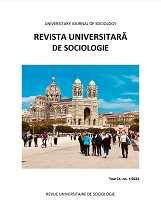CHARACTERISTICS OF PROTECTION INSTITUTIONS AND THE PROCESS OF INSTITUTIONALIZATION
CHARACTERISTICS OF PROTECTION INSTITUTIONS AND THE PROCESS OF INSTITUTIONALIZATION
Author(s): Ionela Maria BRAȘOVEANU (ION)Subject(s): Social development, Social Theory, Sociology of Culture, Sociology of Politics
Published by: Ediktura Beladi
Keywords: institutionalization; social politics; social inclusion; social exclusion; vulnerable groups;
Summary/Abstract: Through this article, I have proposed to approach the integration process from a theoretical perspective socio-professional of young people from the social protection system, as well as the stages they went through for an independent life. Currently, the state through public protection institutions and non- governmental, participate in supporting and supporting the socio-professional integration of this category a young people, thus generating new opportunities and life trajectories in the context of socio-economic both nationally and internationally. The abandoned youth or child follows a predictable path from a family environment to an environment of protective organizations/institutions. In this context we wanted to bring a series of clarifications regarding the sociological concept of institution (with the correlation its institutionalization) in direct connection with the socialization process. Starting from the defined date of Emile Durkheim that the institution represents "external ways of the individual to think, to act and to feel" and the analysis offered by Parsons about the three types of institutions - relational institutions; regulatory institutions and cultural institutions, I begin to describe in chapter two the common elements of protection institutions offered by several authors.
Journal: Revista Universitară de Sociologie
- Issue Year: IX/2023
- Issue No: 1
- Page Range: 232-239
- Page Count: 8
- Language: English

